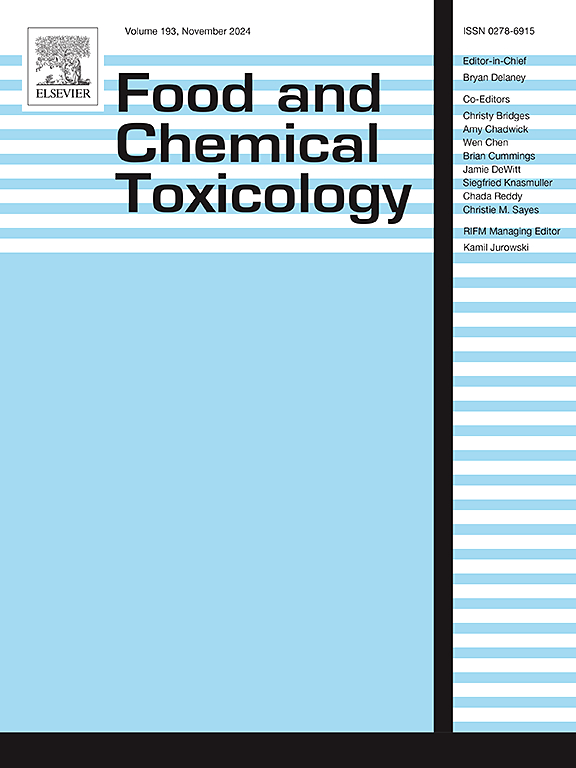IF 3.9
3区 医学
Q2 FOOD SCIENCE & TECHNOLOGY
引用次数: 0
摘要
目的:本研究旨在探讨白藜芦醇是否会影响铅诱导的 HT-22 细胞氧化损伤,从而确定预防和治疗铅诱导的神经毒性的机制和策略:方法:在不同时间段对 HT-22 细胞施加不同浓度的铅和白藜芦醇。首先,我们建立了铅处理(12.5、50 和 200 μmol/L)和白藜芦醇(40 μmol/L)干预研究模型。MTT 用于分析 HT-22 细胞的存活率。细胞死亡率、线粒体膜电位、脂质过氧化和活性氧(ROS)生成率均由流式细胞仪测定。细胞氧化剂(MDA)和抗氧化剂(SOD、GSH-Px)水平用检测试剂盒测定。Western 印迹法用于评估自噬和细胞凋亡相关蛋白的表达:结果:铅以浓度/时间依赖性的方式降低了 HT-22 细胞的活力。此外,铅(200 μmol/L)降低了 BCL2 蛋白的表达,同时增加了 PARP 和 BAX 的表达以及细胞凋亡率。此外,铅暴露组的 ROS、脂质-ROS 和 MDA 水平明显高于对照组。同时,铅暴露组细胞中的 MDA 水平升高,SOD、GSH-Px 和 MMP 水平降低。此外,铅还降低了 SIRT1 蛋白的表达,同时增加了自噬相关蛋白的水平,包括 P62、ATG5、Beclin-1 和 LC3 Ⅱ/Ⅰ。SIRT1的激动剂白藜芦醇(40 μmol/L)可将铅(200 μmol/L)的影响恢复到与对照组无异的水平:结论:白藜芦醇可抑制线粒体损伤,并通过激活 SIRT1 恢复铅诱导的自噬通量阻断和氧化应激,从而减轻铅对 HT-22 细胞的损伤。本文章由计算机程序翻译,如有差异,请以英文原文为准。
The effect of resveratrol on lead-induced oxidative damage and apoptosis in HT-22 cells
Objective
The purpose of this work was to investigate whether resveratrol affects lead-induced oxidative damage in HT-22 cells, characterizing mechanisms and strategies for preventing and treating lead-induced neurotoxicity.
Methods
Various lead and resveratrol concentrations were applied to HT-22 cells over different time periods. First, we established the lead treatment (12.5, 50 and 200 μmol/L) and resveratrol (40 μmol/L) intervention model for the study. MTT was used to analyze HT-22 cell survival rate. The rates of cell death, mitochondrial membrane potential, lipid peroxidation, and reactive oxygen species (ROS) generation were all measured by flow cytometry. Cellular oxidant (MDA) and antioxidant (SOD, GSH-Px) levels were measured with test kits. Western blotting was used to assess the expression of proteins related to autophagy and apoptosis.
Results
Lead reduced HT-22 cell viability in a concentration/time-dependent manner. In addition, lead (200 μmol/L) decreased the protein expression of BCL2, while increasing PARP and BAX expression and apoptotic rate. Moreover, the lead-exposed group had significantly higher levels of ROS, lipid-ROS, and MDA than the control group. This was accompanied by increased MDA levels and decreased SOD, GSH-Px, and MMP levels in the lead-exposed cells. Furthermore, lead lowered SIRT1 protein expression, while increasing the levels of autophagy-related proteins, including P62, ATG5, Beclin-1 and LC3 Ⅱ/Ⅰ. Resveratrol (40 μmol/L), an agonist of SIRT1, restored the effects of lead (200 μmol/L) to levelsindistinguishable from controls.
Conclusion
Resveratrol inhibited mitochondrial damage and restored the lead-induced block of autophagic flux and oxidative stress by activating SIRT1, thereby alleviating lead-induced damage in HT-22 cells.
求助全文
通过发布文献求助,成功后即可免费获取论文全文。
去求助
来源期刊

Food and Chemical Toxicology
工程技术-毒理学
CiteScore
10.90
自引率
4.70%
发文量
651
审稿时长
31 days
期刊介绍:
Food and Chemical Toxicology (FCT), an internationally renowned journal, that publishes original research articles and reviews on toxic effects, in animals and humans, of natural or synthetic chemicals occurring in the human environment with particular emphasis on food, drugs, and chemicals, including agricultural and industrial safety, and consumer product safety. Areas such as safety evaluation of novel foods and ingredients, biotechnologically-derived products, and nanomaterials are included in the scope of the journal. FCT also encourages submission of papers on inter-relationships between nutrition and toxicology and on in vitro techniques, particularly those fostering the 3 Rs.
The principal aim of the journal is to publish high impact, scholarly work and to serve as a multidisciplinary forum for research in toxicology. Papers submitted will be judged on the basis of scientific originality and contribution to the field, quality and subject matter. Studies should address at least one of the following:
-Adverse physiological/biochemical, or pathological changes induced by specific defined substances
-New techniques for assessing potential toxicity, including molecular biology
-Mechanisms underlying toxic phenomena
-Toxicological examinations of specific chemicals or consumer products, both those showing adverse effects and those demonstrating safety, that meet current standards of scientific acceptability.
Authors must clearly and briefly identify what novel toxic effect (s) or toxic mechanism (s) of the chemical are being reported and what their significance is in the abstract. Furthermore, sufficient doses should be included in order to provide information on NOAEL/LOAEL values.
 求助内容:
求助内容: 应助结果提醒方式:
应助结果提醒方式:


